If you have ever made any plans about traveling to Brazil, you have probably looked into the big touristic cities such as Rio de Janeiro, São Paulo, Florianópolis, or Bahia. But sometimes, the best perfumes come in small packages, which means there are quite a few amazing small cities in the country that you should definitely include in your itinerary.
You can visit the beautiful historical sites in Paraty (Rio de Janeiro), get more in touch with nature at Águas de São Pedro (São Paulo), enjoy the beaches and natural wonders at Jericoacoara (Ceará), and even enjoy the wintertime at Campos do Jordão (SP).
In this post, we are going to go over the main small cities you should visit while you are in Brazil. Then, we’ll talk about why you should visit, the main activities you will be able to do in each of them, the best places to accommodate yourself, the best time of the year to travel, and much more!
1. Águas de São Pedro – São Paulo (SP)
General Trip Vibe: relax and heal with thermal water, outdoor activities, get in touch with nature, outdoor exercising
How Many Days Should You Stay: at least 2
Best Time To Visit: all year long
Best Hotels to Stay: Pousada Estrela da Manhã, Pousada Estrela da Manhã, Hotel Portal das Águas
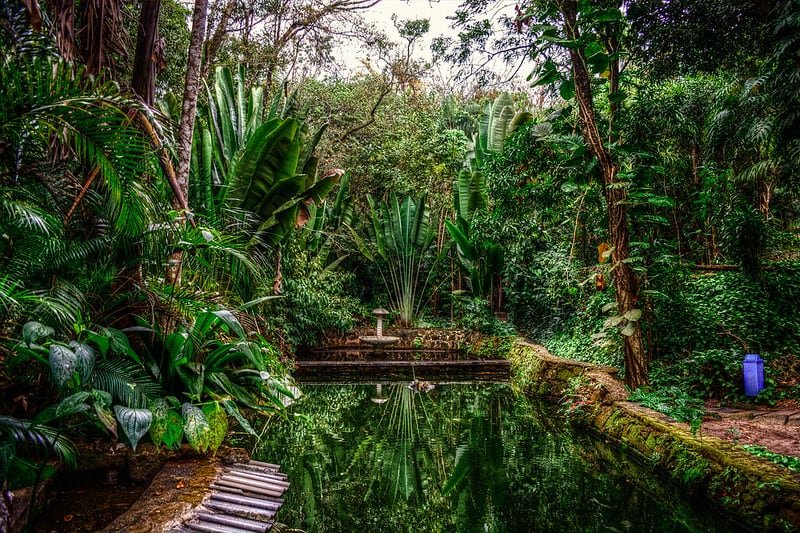
With just a little over 2,700 inhabitants, Águas de São Pedro is a small county located in the state of São Paulo that offers a lot of comfort and outdoor activities to the people coming to visit. In addition to the pleasant climate and cozy environment, the city is one of the Hydromineral Resorts of São Paulo.
The city is known for its hydro-mineral waters of medicinal value, having its natural springs as some of its main tourist attractions. And if that wasn’t enough, Águas de São Pedro has a Human Development Index (HDI) of 0.854, the second-best in São Paulo (as well as the second-best in Brazil), which makes it an excellent place to live (especially if you are looking for somewhere calm and peaceful).
How To Get To Águas de São Pedro?
The city is located just under 112 miles from the city of São Paulo, between the Piracicaba and Brotas counties. So, the best way to get to Águas de São Pedro is by departing from São Paulo, either by car or by bus.
- if you are going by car, just follow the Bandeirantes highway (SP-348), in a journey that lasts, on average, 2h30.
- for those who wish to travel by bus, it is still possible to find a variety of timetables and tickets at the Tietê Bus Terminal, also in the capital. Although not in English, you can check out their website to take a look at the bus schedule.
What To Do in Águas Claras de São Lourenço?
Visit the Fontanário Municipal Water Fountain
The Águas de São Pedro county was blessed by nature with a variety of hydrothermal sources, and that is why the Fontanário Municipal is definitely one of the main destinations for you to visit in the city. The place has three mineral water sources with medicinal properties that help in the treatment of many diseases and provide very relaxing moments.
The fountain is pretty close to the city’s downtown area, and it is open daily from 7:30 AM to 7 PM, with free entry.
Visit the Spa Thermal
The Spa Thermal of Águas de São Pedro is another destination that takes advantage of the city’s hydrothermal waters. The place is a very charming spa that, amongst its many services, has immersions that promise to bring a series of health benefits.
In addition to bathing, the spa also stands out for offering skin, beauty, and massage treatments. The Spa Thermal is open daily from 7:30 AM to 12:30 PM, and Friday and Saturdays also from 3:00 PM to 6:00 PM.
Go Ziplining At Rancho da Tirolesa
Located just over 10 miles from the city’s downtown area, Rancho da Tirolesa is another place in Águas de São Pedro which you should include in your itinerary. Ideal for the whole family, the place promises to please most radical activities lovers, who will be able to go ziplining in the middle of nature.
The Tirolesa Ranch also has a highly praised restaurant and features a unique view of the Serra do Itaqueri; the attraction provides good moments, which are perfect for the end of the itinerary.
Other Things to Do In Águas de São Pedro:
- visit Represa das Palmeiras
- observe the nature at Mini Horto
- spend the day and have fun at Thermas Water Park
2. Guaramiranga – Ceará (CE)
General Trip Vibe: relax, contemplate nature, outdoor activities
How Many Days Should You Stay: at least 3 days
Best Time to Visit: June/July (if you like the cold)
Best Places to Stay: Hotel Chalé Nosso Sítio, Le Rêve Pousada, Hotel Vale das Nuvens, Chalet Schönenberg
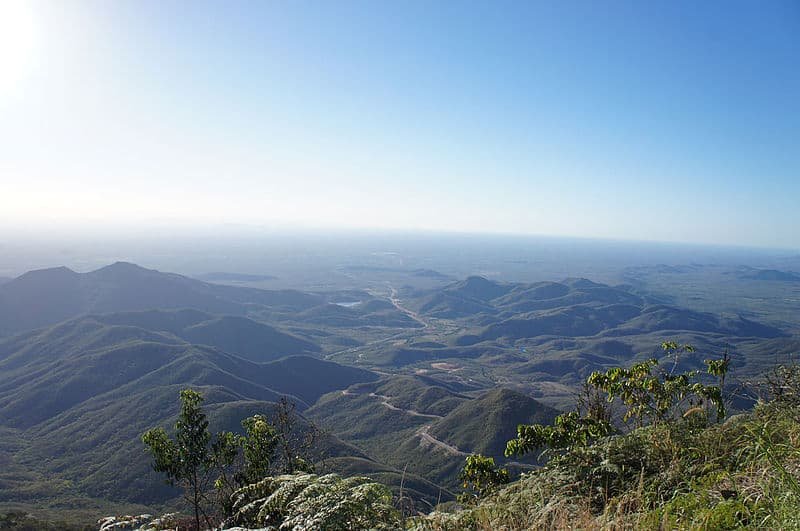
The Northeast region of Brazil is generally known for having the highest temperatures in the country (as it is located very near the Equator Line). Still, Guaramiranga is one of the few exceptions. Since it is located in a mountainous region, this small town has a milder climate, where you can find a preserved area of the Atlantic Forest, with waterfalls, rivers, and trails.
As the city is located in the mountain range area, the average temperatures during the year are between 14°C and 25°C. Therefore, for those who want to enjoy the region during its colder weather, it is best to travel during the months of June and July. But outside of these moments, it is possible to enjoy the mild temperatures and all the attractions of this area of the Atlantic Forest.
How To Get To Guaramiranga?
The best way to get to Guaramiranga is by taking a plane to Fortaleza and then taking a bus to the city. If you are thinking about renting a car, you can just follow the CE 060 highway until Baturité, and after arriving at the city’s entrance, just continue for about 11 miles. From Fortaleza to Guaramiranga is a relatively smooth journey of approximately three hours by car.
What To Do In Guaramiranga?
Visit the Guaramiranga Mountain Range
With an altitude of just over 2700 feet, the Guaramiranga Mountain Range (Serra da Guaramiranga) is the best place to enjoy the place’s exuberant nature in the state of Ceará. In addition, the Mountain Range houses a preserved area of the Atlantic Forest, having a colder and more humid climate, as well as beautiful flowers. So if you like to spend time in nature, definitely include this on your list!
Visit the Handara Park
If you are traveling with family or with a large group of friends, a great thing to do in Guaramiranga is to visit Handara Park. In this place, it is possible to learn a little more about the local flora. In addition, the park has several ecological activities designed for children, such as zip lines, pedal boats, and bouncy sticks, as well as trails for the more active and for adults.
Dive at the Perigoso Waterfall
The Perigoso Waterfall is relatively close to the city’s downtown area and is a place for adrenaline lovers. There is a ten-minute trail that leads to a waterfall of approximately 230 feet, which as the name translates, can be a bit dangerous (perigoso = dangerous in Brazilian Portuguese).
The main thing about this waterfall is that its refreshing waters are ideal for bathing, and it is also a great place to enjoy the natural surroundings.
Other Things to Do In Guaramiranga:
- take pictures at the Pico Alto mountain top
- go trekking and nature watching at Parque das Trilhas
- visit the Jesuítas Monastery
- visit and watch the sun rise at the Linha da Serra Obervatory
3. Paraty – Rio de Janeiro (RJ)
General Trip Vibe: enjoy the beach, outdoor activities, relax, visit some historical sites
How Many Days Should You Stay: at least 3
Best Time To Visit: from March to June
Best Places To Stay: Samblumba Hostel Trindade, Pousada Literária, Pousada Arte Urquijo
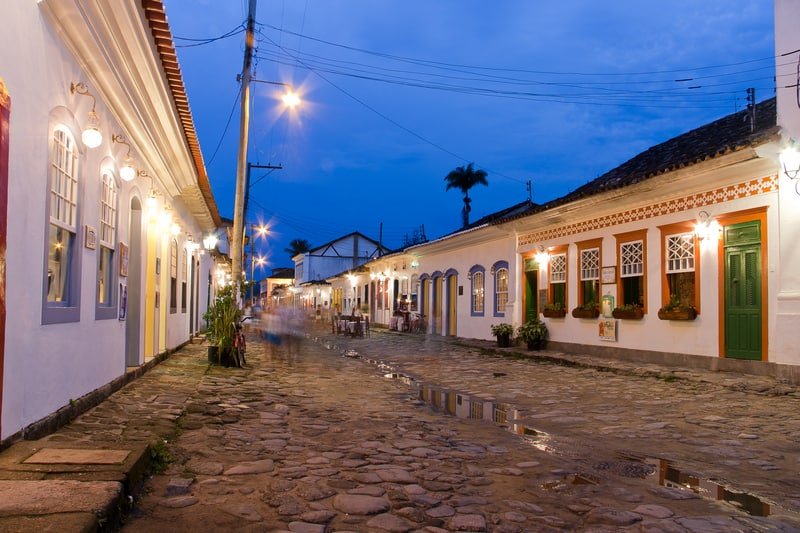
Paraty is a charming city located on the south coast of Rio de Janeiro, famous for its colonial mansions and for being considered a National Historical Heritage in the country. The city’s downtown area is very charming and known for making tourists fall in love with its architecture, colors, and traditions.
Paraty is frequently ranked in the lists of the most beautiful small towns in Brazil, and once you get there, it is clear to see why: with 300 beaches, 65 islands, 5 Atlantic Forest conservation units, and several waterfalls, this coastal town may be small in size, but it offers a lot of natural beauty, history, and local culture.
How To Get To Paraty?
The best way to get to Paraty is by traveling to the city’s closest airport, which is Galeão, located in Rio de Janeiro. From there, you can go by car, on a journey that takes approximately 4 hours, or by bus, departing from the Novo Rio bus station.
What To Do In Paraty?
Visit Praia do Sono
Praia do Sono is one of the most famous beaches in Paraty and is also considered one of the most beautiful on the whole coast. Furthermore, it is located in an almost untouched environmental preservation area, so that you can expect rigid measures in regards to cleanliness.
As it is difficult to access – it is only possible to get there by boat or by walking a not so difficult trail – it is not very busy and is supported by local businesses. While you are there, you can take the opportunity to get to know the local tradition of the residents who preserve the style of the fishing village.
Visit Paraty’s Historical Center
Paraty’s Historical Center is considered by UNESCO as the most harmonious colonial architectural ensemble in the country, and in 1965 the city was established as a National Heritage. To get to know all of the city’s history, there are guided tours that go through the main spots.
Don’t be surprised if while you are touring you find the streets taken by the waters of the sea. The city was designed to allow the entry and exit of ocean water as a natural way of cleaning; therefore, when the tide is strong, some streets in the Historical Center are taken over.
Go Diving at Ilha do Algodão
Famous for being a pit-stop for several boat trips, Ilha do Algodão is the largest island in the region and is recommended for those who enjoy snorkeling and diving in the deep sea. If you’re lucky, you can see the dolphins that usually like to appear on days with colder weather or after the rains.
Visit Saco do Mamanguá
Saco do Mamanguá is an unexplored paradise, and it is considered the only tropical fjord in the world, or in other words, a great inlet of the sea surrounded by high rocky mountains. The green sea follows for an extension of a little under 5 miles.
It has 33 beaches and a preserved mangrove area. The main access to Saco de Mamanguá is by boat, departing from Paraty-Mirim, or by trail, which requires good physical conditioning. If you decide to visit this little piece of paradise, make sure to bring everything you need, as there are no on-site sales outlets.
Other Things to Do In Paraty:
- visit the Museu da Arte Sacra
- visit the Parque Nacional da Serra da Bacaína
- visit other famous beaches such as Praia da Lula, Ilha Comprida and Praia do Cepilho
4. Jericoacoara – Ceará (CE)
General Trip Vibe: beach, relax, enjoy a night out
How Many Days Should You Stay: at least 4 days
Best Time To Visit: from July to December
Best Places to Stay At: Essenza Hotel, My Blue Hotel, Casa na Praia Jeri, Hostel da Praça
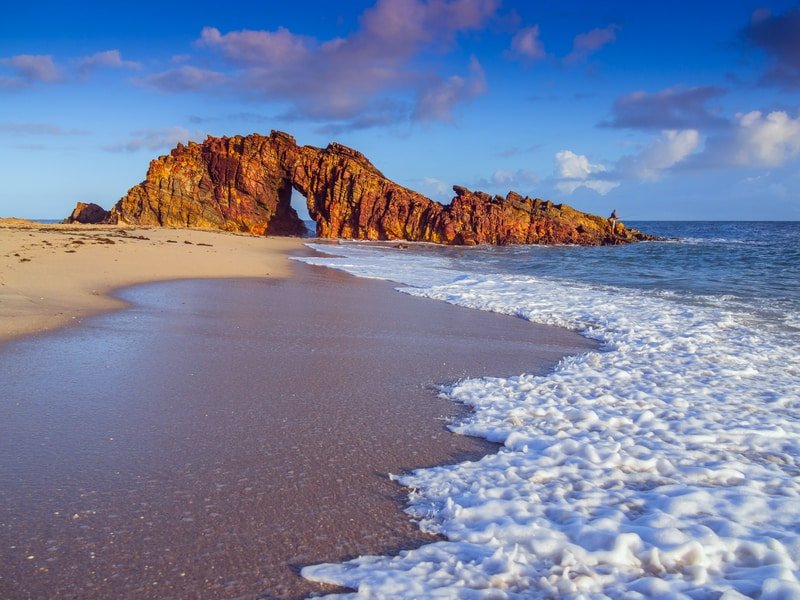
Jericoacoara is a village located in the county of Jijoca de Jericoacoara, in the state of Ceará, Northeastern Brazil. It is located about 168 miles west of the state capital, Fortaleza. Despite the simple setting and the adventure required to reach your destination (we’ll see more on that in the next topic), Jericoacoara has great infrastructure, with many hotels, inns, bars, and restaurants around.
A curious fact about this beautiful village is that it was discovered by immigrants way before it became known by Brazilians, which makes the local customs and gastronomy very influenced by European culture, especially Italian, Belgian, German, and French.
How To Get To Jericoacoara?
We mentioned earlier that a little bit of an adventure is required to reach Jericoacoara. That is because the village is considered an Environmental Protection Area (APA), and as such, the construction of highways and roads is prohibited, as well as any type of pavement, so tourists are obligated to venture on 4×4 on Jericoacoara’s dunes.
After landing at the Fortaleza International Airport (Aeroporto Internacional Pinto Martins – FOR), there are a few different ways to get to Jericoacoara. Unfortunately, none of them is exactly a breeze, as it takes at least 5 hours to get to the city in any of them. However, if you organize your schedule properly, it will definitely be worth the trouble!
So, you basically have three different options:
- You can arrange transportation (transfer) with the hostel you will be staying at. A 4×4 car with capacity for four people costs around USD 175 round trip. This is most definitely the most expensive option.
- You can rend your own car (preferably a 4×4, which is safer on the road). However, it is a complicated alternative to do alone, as the path there is basically a sand dune and the route is very poorly signaled. The ideal thing here is to hire a local to give correct directions.
- The cheapest alternative (USD 12.00) is to take a travel bus that departures from the airport to a town called Jijica. From Jijoca to Jericoacoara, you will be taking a vehicle called “jardineira”, which is basically an adapted 4×4 vehicle.
What to Do In Jericoacoara?
1. Visit The Jericoacoara Beach
The Jericoacoara Beach is famous for its 100 feet high sand dunes, which are the first row seats to one of the most spectacular sunsets you will ever see. There are many rafts in small lakes at the beach, as due to its shallow waters and constant winds, the beach is usually one of the most sought after by sportsmen, especially windsurfers.
But if you are not exactly a fan of windsurfing, no worries! You can just lay at one of the deck chairs and soak up the sun (don’t forget to wear sunscreen!)
2. Ride The Quadricycle To Meet New Places
In Jericoacoara, it is possible to rent quad bike rides and visit new wonderful places, such as Lagoa da Torta, in Tatajuba. If you don’t have a lot of time, you can rent the trip to the Cavalo Marinho lagoon, which lasts about two hours and passes by Mangue Seco Beach, another beautiful location.
3. Enjoy The City’s Night Life
If you want to enjoy a night out at Jericoacoara, head to Rua Principal, where the night begins. Close to the beach, there are caipirinha (click here if you don’t know what caipirinha is) tents that natives and tourists always surround.
After having a few shots, people usually head to the local clubs or to different bars with live music. Among the best options if you want to dance, are Forró da Dona Amédia and Maloka. For snacks and drinks, take a look at Samba Rock, Tortuga, or Zchopp, which are also close to the caipirinha stalls.
And if you are still up when the sun is rising, why not enjoying good delicacies at the famous Padaria Santo Antônio? It opens at two in the morning, and it is a famous pit stop for people heading home after a big party!
Other Things To Do In Jericoacoara:
- take the buggy ride between Lagoa Azul and Lagoa do Paraíso
- watch the sunset at the Sunset Dune, on the left side of the Jericoacoara Beach
- go horseback riding at the beach
- go shopping at the city’s many artisanal shops
- go to Barra Grande (one of our upcoming locations)
5. Domingos Martins – Espírito Santo (ES)
General Trip Vibe: eating well, outdoor activities, enjoying the local festivals
How Many Days Should You Stay: at least 2 days
Best Time To Visit: between June and August
Best Places to Stay At: Pousada Alemã Schwambach, Pousada Japerê, Pousada Pedra Azul, Hotel Fazenda China Park
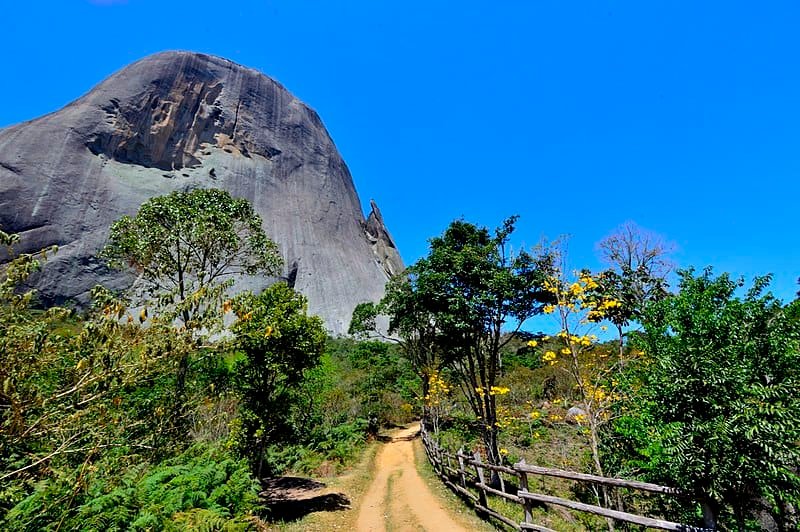
Rolf Gustaf Odelius
Domingos Martins is one of the most famous cities in the mountainside of Espírito Santo, and it draws attention for its very apparent European influence, mainly from Germans, Pomeranians, and Italians. This influence is mostly reflected in the city’s architecture, gastronomy, and some of the various events and festivals that are hosted by the city.
Domingos Martins is located in one of the most beautiful regions of Espírito Santo, so expect nothing but incredible experiences and amazing landscapes. The city has plenty to do in its downtown area, but it is also surrounded by ecological trails and natural attractions that will most likely please all nature lovers.
How To Get To Domingos Martins?
The best way to get to Domingos Martins is to land at the Vitória airport (Eurico de Aguiar Salles – VIX) and then decide on either taking a bus or renting a car to continue the trip.
- If you decide on going by car, the access must be via the BR-262 route, and it is a pretty chill trip that will take about an hour.
- If you prefer, you can also get there by taking a travel bus at the Bus Terminal Carlos Alberto Vivácqua Campos, which is located about 20 minutes from the airport.
What To Do In Domingos Martins?
1. Visit Dr. Arthur Gerhardt Square
Praça Arthur Gerhardt is one of the most charming locations in the city, and it is perfect for a family outing. The place is surrounded by big trees and beautiful flowers, as well as many typical attractions. It is also possible to visit the local artisanal craft fairs and several old mansions.
2. Visit the Pedra Azul State Park
The Pedra Azul State Park is located 21 miles away from Domingos Martins’s downtown area, and it is the most visited attraction in the city. The region is home to several species of local plants and animals and has incredible ecological trails.
The location also has very good infrastructure, with a restaurant, parking and small shops, being the perfect location to spend at least a portion of your day.
3. Enjoy a Few Drinks at Rua do Lazer
Although it is pretty crowded during most of the day, Rua do Lazer is also a good place to enjoy the night. Located in downtown Domingos Martins, the street houses several options of bars and restaurants that specialize in the city’s cuisine. The space is ideal for having a few drinks, grabbing something to eat, go shopping, and going out with friends and family.
Other Things To Do In Domingos Martins:
- visit Bosque das Cerejeiras
- take the Rota do Lagarto Tour
- go to the Zoo Park da Montanha
- enjoy the local festivals, which include Sommerfest, Vila da Páscoa and Festival de Inverno (the biggest music event in the state)
6. Barra Grande – Piauí (PI)
General Trip Vibes: great for kitesurfing, relaxing, enjoying the nature
How Many Days Should You Stay: at least 3 days
Best Time To Visit: from August to December
Best Places To Stay At: Terra Patris! Atellier Pousada, Manatí Hotel, Pousada BGK, Casa Areia Pousada, Raízes Eco Hostel
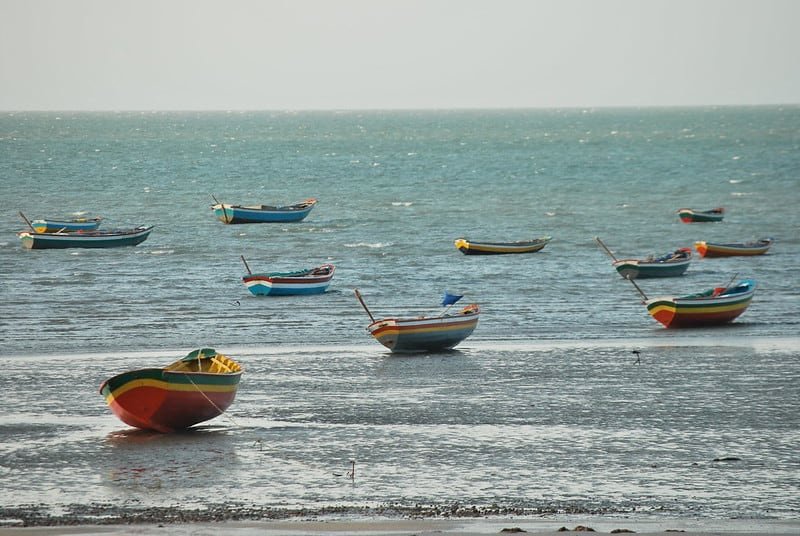
Located in the Cajueiro da Praia county, Barra Grande is a fishing village on the coast of Piauí, Northeast of Brazil. The place is the ideal destination for those who want to enjoy simpler and relaxing days, with beautiful landscapes to contemplate on.
The Barra Grande coast is filled with white sand, sapphire-blue, and warm seawater all year round and 41 miles of beautiful beaches that, most of the time, are empty and quieter. The local gastronomy is also very present in the region, especially in its fish and seafood dishes.
I mean, there is nothing better than sitting at a bar on the sand eating fresh fried fish, having a cold beverage, and enjoying the evening, right?
How To Get To Barra Grande?
Departing from Jericoacoara
In our previous Jericoacoara topic, we have listed going to Barra Grande as one of the places to visit, as it is pretty easy to include both of them in your travel itinerary. So here’s how you can get to Barra Grande if you are departing from Jericoacoara:
- By Car – If you don’t mind driving from Jericoacoara to Barra Grande, you can rent a car in Jericoacoara and only return in Parnaíba, a city close to Barra Grande. It should take you about 3 h 30 minutes to get there.
- Hire a Driver – Renting a private transfer in a Hilux from Jericoacoara to Barra Grande costs around USD 130.00 and the car can take up to 4 people.
- Shared Transfer – To go from Jericoacoara to Barra Grande, you can also take the shared transfer. The transfer is made on Mondays, Wednesdays and Fridays and the value per person is USD 25.00.
Departing from Outside Brazil
The best way to get to Barra Grande if you are coming from outside the country is by landing at Parnaíba’s International Airport (Prefeito Doutor João Silva Filho – PHB/SBPB) and continuing the trip on the road. From the Parnaíba Airport, you can get to Barra Grande:
- By Uber or Transfer Driver – an Uber ride to Barra Grande costs around USD 30, but you could also hire a driver in advance.
- By Car – If you would like to have more autonomy over your trip, it is a good idea to rent a car in Parnaíba and take one of the two main routes to Barra Grande. One of them goes outside the city and the other one along the coast. If your route includes Jericoacoara, it is possible to rent a car in Parnaíba and return it in Jericoacoara.
- By Bus – In Parnaíba, you will be able to find a bus line that takes you to Barra Grande. It is open from Monday to Saturday and takes you directly to the city’s main square.
Buses have the advantage of you not having to worry until you get there, but it will take about two hours to get to Barra Grande, as it stops in many places along the way. The average ticket costs around USD 3.00.
What To Do In Barra Grande
Take The Cavalo Marinho EcoTour
The Cavalo Marinho EcoTour is a very good option for those who want to really get in close contact with nature and be able to learn more about the local fauna and flora. The highlight of the tour obviously is the observation of seahorses in their natural habitat, which most definitely delights people of all ages.
Go Kitesurfing at Barra Grande Beach
Outdoor sports practice is one of the main activities in Barra Grande, even for people outside the country. The Barra Grande beach is a well-known spot for kitesurf lovers. The season most sought after by athletes is from July to January, when the winds are stronger.
Go On The Delta do Parnaíba Tour
The Delta do Parnaíba site is one of the most interesting landscapes in Brazil. You will come across freshwater beaches, dunes, lakes, and rivers in an exuberant natural setting perfect for some unforgettable moments. It is pretty nice to do this tour on speedboats, which go through several channels, but you can also take a regular traditional boat.
It is recommended to take this tour between the months of May and August when there is less rain.
7. Trancoso – Bahia (BA)
General Trip Vibe: learn more about the local history, enjoy the natural wonders, enjoy the local food
How Many Days Should You Stay: at least 3 days
Best Time To Visit: from November to April
Best Places To Stay At: Casas da Lia, Pousad,a Jardim das Margaridas, Pousada Aldeia do Sol, Vila Morena Trancoso, Pousada Ouro Sobre Azul II
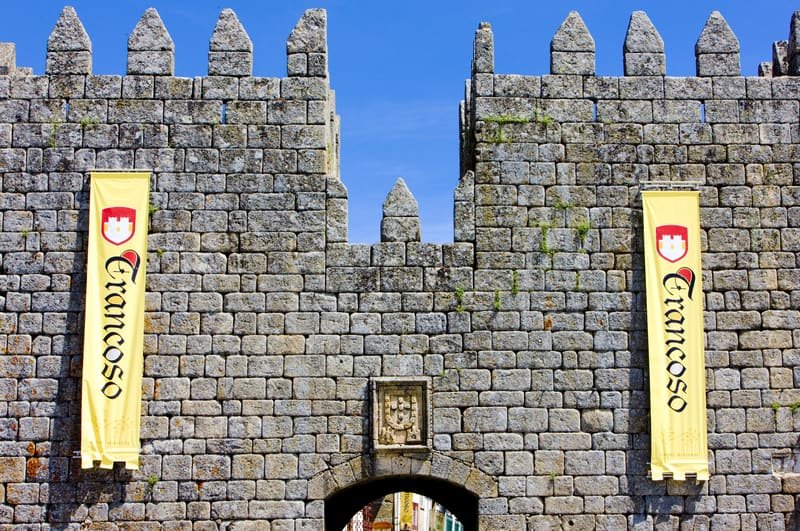
Located in Porto Seguro, Bahia, Trancoso can be best described as paradise on Earth. That is because the overall structure of the district, which began to receive more tourists in the mid-1990s, still preserves most of the local natural beauties, having that charming wild beach flair intact.
But don’t Trancoso’s rustic appearances fool you! Despite its simplicity, the village offers the best to its tourists, such as highly praised five-star hotels and restaurants. Moreover, most of the things can be done within walking distance in Trancoso, as the district’s downtown area is closed to vehicles, which adds even more to that feeling of disconnecting with the big city.
How To Get To Trancoso?
The best way to get to Trancoso is by landing at the Porto Seguro International Airport (BPS), which is the nearest airport to the city. From the airport, you can get to Trancoso by car, bus, taxi, Uber, or hiring a private transfer driver:
- Bay Car – there are two main routes you can take to get to Trancoso by car. The first (the shortest – 30 miles) runs across Arraial d’Ajuda, where you will need to take the ferry crossing between Porto Seguro and Arraial d’Ajuda. The other route (which is longer – 48 miles), is through the BR-367 highway and then follow through BA-001. It is worth mentioning that the quality of the road is not the best, so make sure to pay close attention.
- By Bus – now, if you are on a budget, the most economical option to get to Trancoso is taking the bus from Arraial d’Ajuda. In this case, youy will need to take an Uber to the ferry harbor, take the ferry to Arraial da d’Ajuda, and then take the bus from Arraial d’Ajuda to Trancoso. It may seem like a really long quest, but it isn’t that bad really, and you’ll get to see many beautiful scenarios on your way there.
- By Uber/Private Driver – finally, if you are looking to get to Trancoso in the fastest and most comfortable way, calling for the Uber service, taxi or hiring a private transfer driver from Porto Seguro Airport is the best choice. Uber rides are approximately USD 30.00 to take up to 4 people there. The average cost of a private transfer driver is around USD 50.00 and you can ask in your hotel if they have a reliable person to recommend.
What To Do In Trancoso
Have a Drink at Quadrado
The Quadrado is one of the main attractions of Trancoso, being a place with an important historical background for the region. It was here that the first Jesuit village was built in 1586, remaining for many centuries as a hidden place.
In the ’70s, this famous group of houses started gaining color, and over the years, it slowly turned into the district’s commercial center. During the day, the Quadrado location is the perfect spot for many Instagrammable pics, mainly due to its striking and beautiful colors.
But the place gets even more alive at night, when the restaurants and local bars light the candles on the outside tables, making the scenery even more beautiful.
Visit the Itaquena Wild Beach
If you want to lay down in a semi-deserted, extensive wild beach bathed by clear water, then the Itaquena beach must definitely be on your itinerary. The site is one of the most untouched and remote in the region, located halfway between Trancoso and Praia do Espelho, in an environmental protection area called Reserva da Vida Selvagem do Rio dos Frades.
Since the beach is pretty deserted, don’t forget to take some snacks if you are thinking about spending the whole day there (and don’t forget to bring your trash bag with you too!).
Visit the Rio Verde Beach
Now, if wild beaches aren’t really your thing, then the Rio Verde coast might be right up your alley. The beach is surrounded by bars and restaurants, not to mention a few beach clubs famous for rocking the shores (Paradise and Bahia Bonita are some of them). The waves are strong and ideal for surfing as well.
Other Things to Do In Trancoso:
- visit the Itapororoca Beach
- visit Praia do Espelho
- visit the São João Batista square
- visit the Taípe Beach
8. Campos do Jordão – São Paulo (SP)
General Trip Vibe: eat good food, enjoy the cold weather in Brazil, marvel at the local architecture
How Many Days Should You Stay: at least 3 days
Best Time To Visit: from March to August
Best Places To Stay At: Golden Park Campos do Jordão, Dan Inn Campos do Jordão, Hotel Leão da Montanha, Nacional Inn Campos do Jordão
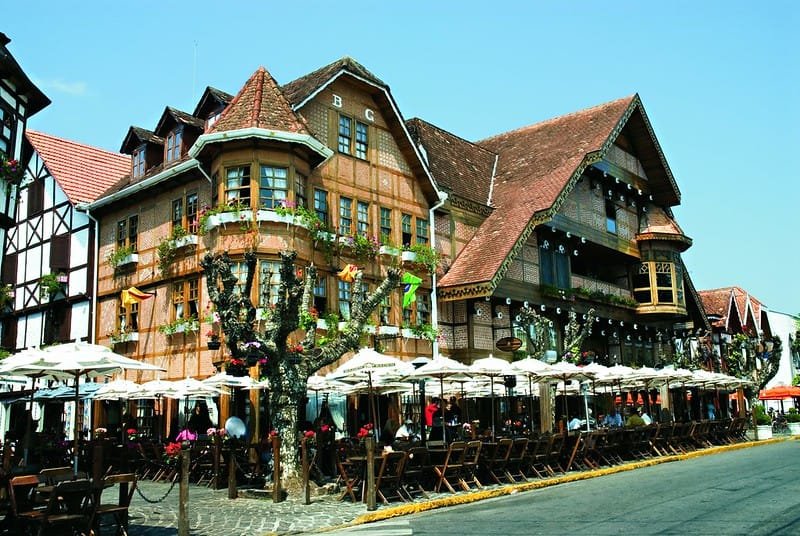
Locally known as the “Brazilian Switzerland,” Campos do Jordão is a small town located in Serra da Mantiqueira, in the countryside of the São Paulo state. Due to its altitude (1600 meters above the sea), Campos do Jordão is a perfect destination for chilly weather lovers, and it also has great infrastructure and several attractions for the most diverse types of tourists.
The city’s gastronomy is another local highlight, having many restaurants of international standard, but with a focus on regional products such as olive oil, mushrooms, trout, chocolate, among others. Finally, Campos do Jordão houses 4 amazing local breweries for the beer enthusiasts, so get ready for some serious tastings!
How To Get To Campos do Jordão?
The best way to get to Campos do Jordão is by flying to the Guarulhos International Airport (GRU) in São Paulo and then taking a bus, an Uber, or renting a car to finish the rest of the trip. Campos de Jordão is located about 94 miles from São Paulo, and it should take you around 2 and a half hours to get there.
What To Do In Campos do Jordão?
Visit The Vila Capivari District
Vila Capivari is one of the busiest neighborhoods in Campo de Jordão, housing a lot of attractions for those looking to enjoy the city both during the day as well as during the nighttime. The district almost looks like something out of a European movie, with its local architecture decorated in true Colonial style.
There are a lot of restaurants, bars, bakeries, and cafés around, which is why the district is always so busy. There are also some pretty cool gift stores for you to buy a few souvenirs to bring home.
Visit The Felícia Leiner Museum
Felícia Leiner was a Polish artist who came to Brazil in 1927. Fast forward a few years, and during one of her trips around the country, she came across Campos de Jordão while in search of a peaceful place and decided to settle in after falling in love with the city.
In 1978, she founded the museum, and it has ever since become a must-see attraction in Campos do Jordão for all art enthusiasts. There are sculptures on display in the indoor and outdoor areas, and there is also a very delicious restaurant so you can recharge your energies!
Visit The Horto Florestal State Park
The Horto Florestal State Park has over 20k acres of green, being a perfect place for a picnic with the children and also for trekking on the two existing trails: the Cachoeira Trail (which is 2,7 miles long), and the Campos make Timoni Trail, which has around 1,8 miles. Also, make sure to visit the exhibition center and the small chapel there; they are both very charming.
Other Things To Do In Campos do Jordão:
- take lots of pictures at the Pico do Imbiri
- watch the sunset at the Vista Chinesa observatory (Belvedere)
- ride the cable car up to Morro do Elefante
- go fishing at the Pesca na Montanha EcoPark
- go beer tasting at the Cervejaria Baden Baden brewery
Oh, and for those who enjoy good music, it is also worth visiting Campos do Jordão during the wintertime when the Campos de Jordão International Winter Festival takes place. The festival is considered one of the best classical music events in the country and usually takes place in July.
9. Morretes – Paraná (PR)
General Trip Vibe: enjoy the local culinary, outdoor activities, visit beautiful waterfalls
How Many Days Should You Stay: at least 3 days
Best Time To Visit: from December to March
Best Places To Stay At: Casa da Estação, Pousada Bella Morretes, Pousada Dona Laura, Pousada Cidreira, Porto Real Hotel
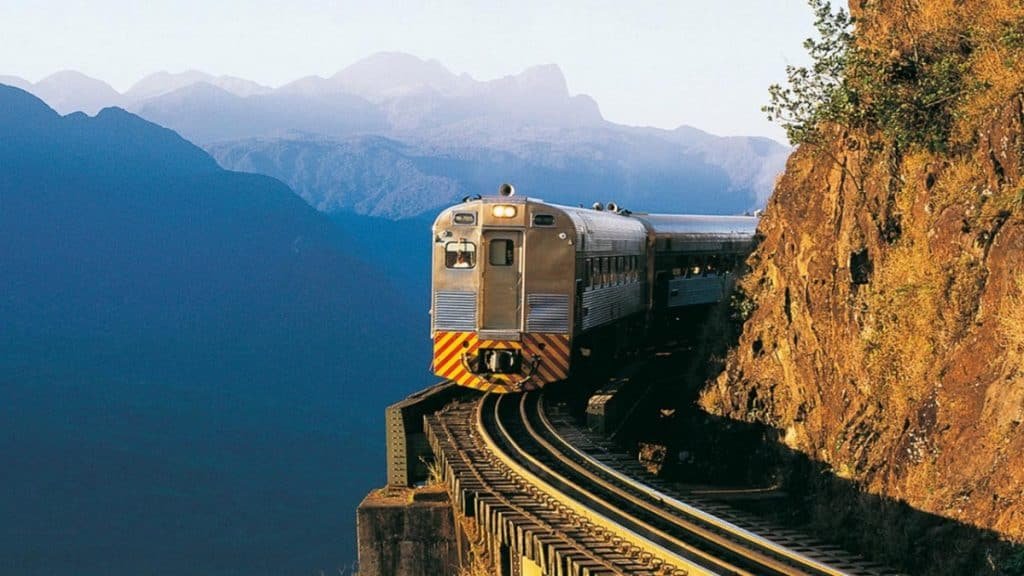
Morretes is a super cozy city located in between the mountains and the coastal area of the state of Paraná. In its historic center (located on the banks of the Nhundiaquara River), there are several Colonial mansions that house the local restaurants, bars, cachaçarias, and artisanal craft shops.
One of the main highlights of this small coastal town is a locally famous dish called barreado, which consists of a large piece of meat that is cooked in a clay pot for almost 20 hours. The dish has a unique seasoning, also being served with flour and bananas on the side.
How To Get To Morretes?
The best way to get to Morretes is by landing at the Curitiba International Airport (Aeroporto Internacional Afonso Pena – CWB). Then, you can choose between getting to Morretes by bus or by renting a car, but the coolest way to get there is by using the train service.
It takes just under four hours to cross one of the oldest railways in the country, cutting through tunnels, bridges, descending the Serra do Mar mountain, and observing the natural beauties of the Atlantic Forest reservation. It may take you a while to get to Morretes, but the train trip is surely worth all the trouble!
What To Do In Morretes?
Visit the Nhundiaquara River And its Surroundings
Morretes was born on the banks of the Nhundiaquara River, and this scenario is still one of the main highlights in the region. Around the metallic bridge that crosses the river, you will find a conglomerate consisting of several restaurants and bars, a famous spot with very good infrastructure. In addition, locals say that watching the sunset sitting at the Nhundiaquara River is an obligatory activity, so don’t miss out on that as well!
Visit the Pico do Marumbi State Park
For those who want to get the adrenaline pumping, visiting the Pico do Marumbi State Park is the ideal thing to do. The park is filled with waterfalls, trails, and beautiful peaks, but it is recommended to have an experienced guide to take you there, as the place is a little bit difficult to access when you don’t know your way around it.
If you happen to visit the park during the hot weather season, then you must visit the Salto dos Macacos waterfall as well, which is known for its natural stone “slides.” The natural pool (with a breathtaking view and no borders – which makes it look like a natural infinity pool) can be accessed after a two-hour walk, and diving into its waters surely is the best way to celebrate your hard work!
Visit The Nearby Beaches
Morretes is located about 30 miles from Pontal do Paraná, a nearby coastal city that houses beach resorts such as Praia de Leste, and Pontal do Sul. So, if you want to fit a few days at the ocean in your itinerary, you can get to the shores pretty quickly from Morretes.
The Praia de Leste beach is a definite crowd-pleaser with its beautiful calm sapphire blue waters and soft sand. In addition to all the natural beauty, the place also has a pretty good infrastructure, with lots of vendors and beach apparel rental (chairs and/or umbrellas) on the sand. There are also restaurants and shops on the outskirts of the beach.
Other Things To Do In Morretes:
- have a one of a kind gastronomic experience at Celeiro Ecogastronomia
- visit the historic houses at the city’s downtown area
- have a few drinks and dinner at Empório do Largo
- learn more about the local history at Paraná Encantado HISGEOPAR
- visit the Ekôa Park
10. Baía Formosa – Rio Grande do Norte (RN)
General Trip Vibe: relax at the beach, outdoor activities
How Many Days Should You Stay: at least 2 days
Best Time To Visit: from June to January
Best Places To Stay At:
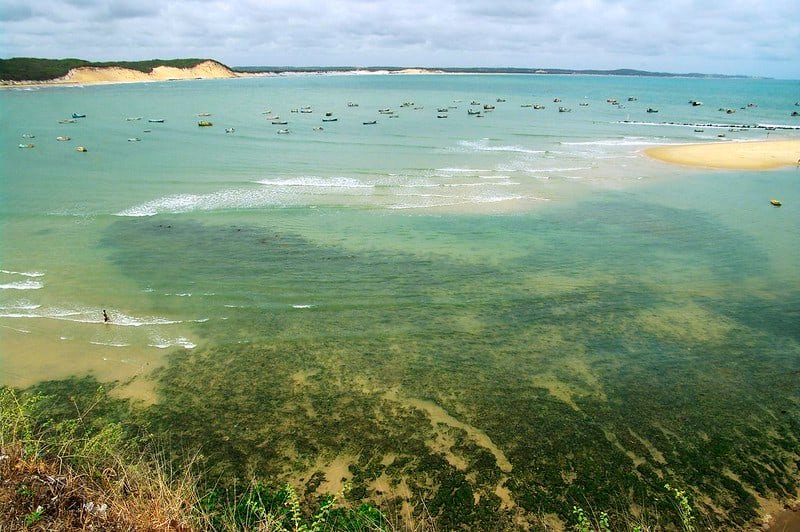
Baía Formosa is a small town located about 55 miles from Natal, the capital of Rio Grande do Sul. Surrounded by lush nature and beautiful cliffs, the region has natural pools and some of the most beautiful beaches in Brazil. Also, this little paradise is the perfect spot for adventurers and surfers.
That is because Baía Formosa has over 16 miles of beaches housed by its coast, so you won’t have much trouble finding a quiet spot in case you want some peacefulness. The city itself has a little bit of everything; there are options for those who just want to relax and enjoy the sea and also for those who want to have fun and party a little.
How To Get To Baía Formosa?
The best way to get to Baía Formosa is by landing at the Natal International Airport (Aeroporto Internacional Augusto Severo – NAT) and then concluding the rest of the trip on the road. However, you can also choose to land at the João Pessoa International Airport (Aeroporto Internacional Presidente Castro Pinto – JPA), as they both have the same distance from baía Formosa.
You can take a travel bus to Baía Formosa from either one of the airports or rent a car to drive there, which should take you a little over an hour. Renting a car is always a nice option, as it lets you have more autonomy in regards to the neighboring places you could be visiting.
What To Do In Baía Formosa?
Visit Praia da Cacimba
Praia da Cacimba is one of the main beaches in Baía Formosa, and it attracts a lot of tourists in the region due to its paradisiac surroundings. Therefore, this is a beach that will surely please most different visitors, from those interested in relaxing or just swimming in the sea to the more adventurous, who want to crash into the waves – which can reach mind-boggling heights, FYI!
Visit the Baía Formosa Observatory
The Baia Formosa Observatory is one of the best ways to observe and take in most of the beauty of the region. Located in a privileged position, this observatory offers a unique view of the local beaches and cliffs, which allows for some pretty awesome pictures.
The sunset is a time when most locals and tourists gather to witness the beautiful horizon and its different colors, so make sure to get there early and catch the best spot!
Bathe In The Natural Pools
As many of the beaches in Baía Formosa are formed by rocks or sandbanks close to their shores, it is possible to enjoy the natural pools that form during the low tide, which is the ideal time to enjoy the sun-warmed waters and take a dip in the sea.
The natural pools are also a great place for children, as the little ones can swim and cool off safely without having to worry about big waves or drowning.
Other Things To Do In Baía Formosa:
- visit the Bacupari Beach
- take the buggy ride tour across the beaches
- take the boat tour (there are high chances of seeing dolphins!)
- go surfing at Baía dos Golfilhos
11. Aiuruoca – Minas Gerais (MG)
General Trip Vibe: enjoy the beautiful landscapes, enjoy the local food, outdoor activities
How Many Days Should You Stay: at least 2 days
Best Time To Visit: from June to January
Best Places To Stay At: Pousada Pico do Papagaio, Pousada do Waldir, Pousada Recanto das Flores, Chalé Vale do Cangalha, Chalé na montanha Matutu
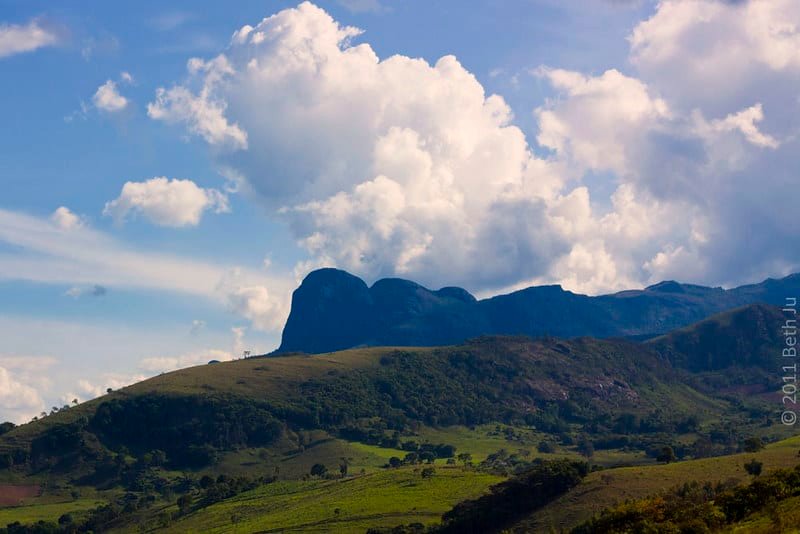
The historic cities of Minas Gerais are well known in Brazil, but the Aiuruoca district is a clear highlight from the rest of them. With about six thousand inhabitants, the city is a small paradise surrounded by nature located in Serra da Mantiqueira, at an altitude of 1,050 meters.
The many waterfalls, wells, trails in the middle of the forest, and the beautiful viewpoints are the clear stand-outs of the region, with Vale do Matutu and Vale dos Garcia being home to the most popular waterfalls, such as Macacos and Fadas.
How To Get To Aiuruoca?
The best way to get to Aiuruoca is by landing in any of these three airports:
- the Belo Horizonte International Airport (Aeroporto Internacional de Confins -CNF)
- the São Paulo International Airport (Aeroporto Internacional de Guarulhos – GRU)
- the Rio de Janeiro International Airport (Aeroporto Internacional Tom Jobim – GIG)
You can rent a car from any of the three airports and drive to Aiuruoca, which should take between 4 to 5 hours (depending on the traffic and your overall speed). If you are not comfortable driving for so long, you can take a bus at the local bus stations or hire the services of a qualified driver (which the hotel you’ll be staying in will probably be able to recommend).
What To Do In Aiuruoca?
Visit the Beautiful Local Waterfalls
If you are visiting during the hot season, then why not cooling off at the local waterfalls? Amongst the many choices, you can visit the Cachoeira do Fundo waterfall, as well as Deus-Me-Livre, Cachoeiras das Fadas, Vale dos Garcia, and a few others.
If you are a fan of long walks and trekking, you will find the Joaquim Bernardo well on the way to the Vale dos Garcia waterfall, where you can enjoy stone slides and some delicious natural hydro massages. The trail that leads to the Cachoeira do Fundo waterfalls requires a little bit of physical preparation, but you can bet that the scenery of all these trails is damn worth the effort!
Fill Your Tummy With Delicious Food
If you know anything about Minas Gerais, then you might be aware that the local cuisine is just absolutely DELICIOUS. I mean, sorry for the caps, but this is actually my favorite type of regional culinary in Brazil, and if you haven’t had any “comida mineira” (how Brazilians refer to the food made in Minas Gerais) yet, prepare to fall in love.
Walk Around the Town’s Center Area
Located in Aiuruoca’s central region, the town’s square is a charming little place, with a cozy gazebo and a few benches that are certainly inviting for you to take a moment and enjoy the peaceful vibes of the city. There are several restaurants and snack bars around the square as well.
There are also several shops around selling artisanal products, but don’t leave all your shopping to the last minute, as most of them close by 5 PM! Oh, and if you happen to be in town on a Sunday, there are always Forró dances at the square every Sunday night!
And if you don’t know how to dance de Forró, don’t worry! We covered that and many other traditional Brazilian dances in this post, so you can practice until you get to the country!
Other Things to Do In Aiuruoca:
- visit the Casarão do Matutu, a local historical museum located at Vale do Mututu
- visit the waterfall at Vale dos Garcias, said to be the most beautiful waterfall in the region
- visit the Serra do Papagaio State Park
- watch the stars during the night time, as because of the altitude, you’ll feel closer to the skies 😉
12. Cabaceiras – Paraíba (PA)
General Trip Vibe: visit Brazilian cinema famous locations, enjoy the beautiful landscapes, enjoy the local festivals and parties
How Many Days Should You Stay: at least 2 days
Best Time To Visit: from June to January
Best Places To Stay At: Pousada Familiar Shalom, Flor de Mandacaru Pousada, Pousada Glória, Hotel Casa Blanca Express
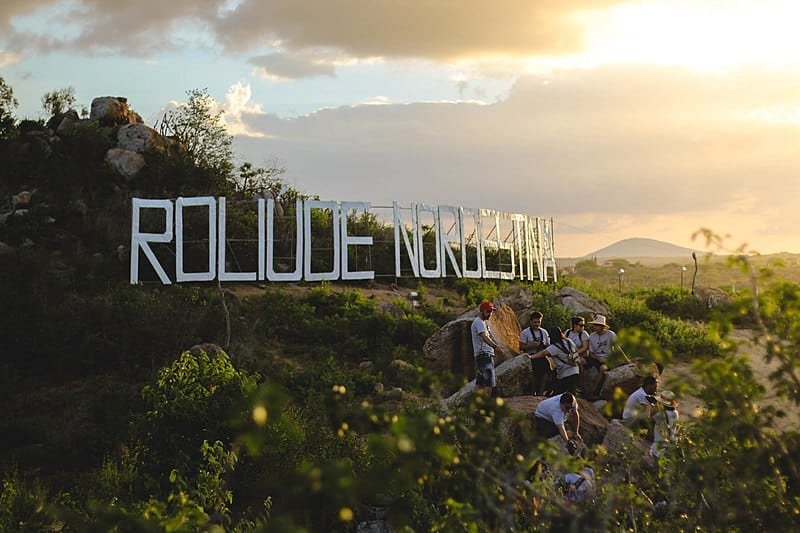
Located in the Northeast region of Brazil, this city of five thousand inhabitants is one of the most important tourist destinations in Paraíba. Cabaceiras is locally known as the “Brazilian Hollywood” for having served as background to over 30 Brazilian cinematographic productions, including the film “O Auto da Compadecida.”
The colorful houses at Cabaceira’s historic center are one of the reasons why tourists love coming to the city, but Cabaceiras also has many other tourist attractions, such as the Lajedo do Pai Mateus and the Cinematographic Memorial.
How To Get To Cabaceiras?
The best way to get to Cabaceiras is by landing at the João Pessoa International Airport (Presidente Castro Pinto Airport – JPA), taking a bus at the city’s bus station to Campina Grande, and from there, taking another bus to Cabaceiras.
If you are any good with directions and has a valid license to drive in the country (take a look at this guide we made to learn more about it), you could always rent a car at the airport and drive to Cabaceiras yourself, which should take you just under 3 hours.
What To Do In Cabaceiras?
Visit the “Roliude” Sign
Right at the entrance to the city, you will come across a giant sign written in white that says “ROLIÚDE NORDESTINA” – a Brazilian take on “Hollywood from the Northeast” and an obvious nod to the original Hollywood Sign.
As we stated earlier, the city has been the stage of many Brazilian movie productions, mainly because there are very few chances of rain in the city most of the time. Some of the movies shot in Cabaceiras include Madame Satã, Canta Maria, Beiço de Estrada, Por Trás do Céu, Viva São João, and O Auto da Compadecida.
Visit The Film Memorial (Memorial Cinematográfico)
And of course, what would the Brazilian Northeast “Roliude” be without a small museum filled with photos of the recordings in which the city served as a background, right? Overall, the Film Memorial houses photographs and clippings from newspapers and magazines that had pieces on the films that were shot in Cabaceiras. Although very simple, it is a pretty cool place to visit!
Have Fun At The Bode Rei Festivity
Cabaceiras is a pretty chill and deserted city most of the year, except during the season of the Bode Rei festival, which is very traditional. The festival houses fairs, courses, crafts, competitions, dances (especially forró pé-de-serra) and has plenty of delicious food as well, including the locally famous tapioca filled with goat meat. The festival takes place from May to June, so make sure to stop by if you are in town!
Other Things To Do In Cabaceiras:
- have drinks and shop at Bar do Zé de Cila
- visit the Matriz Nossa Senhora da Conceição Church, where the O Auto da Compadecida movie was shot
- visit the Lajedo de Pai Mateus rock formation (there are only 2 other rock formations in the world like this one)
- visit the História e Museu da Cultura Cariris Paraibanos museum
So, that was it for our amazing 12 cities you should visit in Brazil! There are plenty of amazing places to visit throughout the country, and I hope we were able to give you a little taste of some of the locations you could include in your next trip!
While you are here, I think we might interest you with these:
Where To Go From Rio: 19 Places for Amazing Short Trips – if you are already familiar with the city of wonders, how about getting to know a few of the amazing locations you can visit just outside Rio de Janeiro? Click here to get to know 19 of them!
Travel to Brazil for cheap: 19 tips for a budget-friendly trip – worried that your tight budget might spoil your trip to Brazil? Well, worry no more, my friend, because we have 19 good news for you! Click here and check out how you could make your trip much more budget-friendly!
South Brazil Itinerary: travel through the REAL South – the South is the biggest region in Brazil, and therefore, houses some pretty amazing destinations waiting for you to visit. Click here and take a look at our itinerary suggestions so you can get to know the real south of Brazil!
Cover Photo: people enjoying a night out at Campos do Jordão, São Paulo – Credit: WikiCommons | Deni Williams
